NATURE-CULTURE
8.4
LEARNING OBJECTIVE
Understand how nature-culture relations are expressed through the production and consumption of food.
Agriculture has been the fundamental encounter between nature and culture for more than 10,000 years, as human labor is mixed with nature’s bounty to produce our sustenance. What we eat and how we eat it are a basic source of cultural identity. At the same time, thousands of years of agricultural use of the land have led to massive alterations in our natural environment.
TECHNOLOGY OVER NATURE?
Historically, climate and the physical environment have exerted the greatest influence on shaping agriculture. People have had to adjust their subsistence strategies and techniques to the prevailing regional climate conditions. In addition, soils have played an influential role in both agricultural practices and food provisioning. Swidden cultivation, in part, reflects an adaptation to poor tropical soils, which rapidly lose their fertility when farmed. Peasant agriculture, by contrast, often owes its high productivity to the long-lived fertility of local volcanic soils. Terrain has also influenced agriculture, as farmers tended to cultivate relatively level areas (Figure 8.27). In sum, the constraints of climate, soil, and terrain have historically limited the types of crops that could be grown and the cultivation methods that could be practiced.
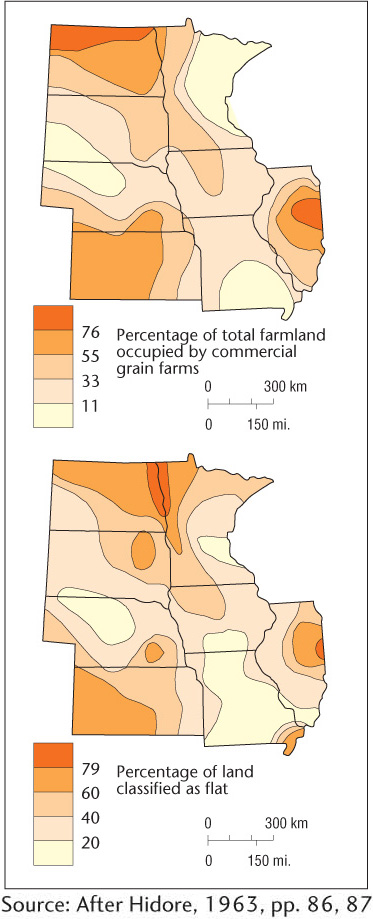
In recent centuries, markets, technology, and capital investment have greatly altered the spatial patterns of agriculture that climate and soils had historically shaped. Expanding global-scale markets for agricultural commodities such as sugar, coffee, and edible oils have reduced millions of acres of biologically diverse tropical forests to monocrop plantations. Synthetic fertilizers and petroleum-based insecticides and herbicides, widely available in developed countries after World War II, helped boost agricultural productivity to unimagined levels. Massive dams and large-scale irrigation systems have caused the desert to bloom from central Asia to the Americas, converting, for example, the semiarid Central Valley of California into the world’s most productive agricultural region.
347
The ecological price of such technological miracles is high. Drainage and land reclamation destroy wetlands and associated biodiversity. The application of synthetic fertilizers results in nutrient-rich runoff from farms that enters freshwater systems as pollution, lowering water quality, destroying aquatic habitat, and reducing biodiversity. Agrochemicals also enter the environment as runoff, as residue on food crops, and in the tissues of livestock. These chemicals ultimately reduce biodiversity, pollute water systems, and cause increases in the rates of cancer and birth defects in humans and animals.
In the context of global climate change, great concern exists about the long-term sustainability of modern agricultural practices that rely on large-scale irrigation. In many parts of the world, groundwater is being pumped to the surface faster than it can be replenished and reservoirs are approaching the end of their life spans. Well-and-pump irrigation has drastically lowered the water table in parts of the American Great Plains, particularly Texas, causing ancient springs to go dry. Climate change data from the distant past and computer models of future climate conditions suggest that the U.S. Southwest is likely entering a drier climate regime.
The Colorado River Basin provides a disturbing example of the challenges climate change poses for agriculture in the Southwest. Its dams and reservoirs irrigate 5.5 million acres of farmland. Lake Mead, the giant reservoir in Arizona and Nevada that helps supply water to California’s farms, has not reached full capacity since 1983 and is unlikely ever to be full again (Figure 8.28). By 2010 its capacity stood at only 39 percent capacity and the future looks drier than ever. The year 2013 marked 14 years of drought in the region, the worst in 100 years. Most climate change models predict that this region’s climate is shifting toward a hotter and drier norm with more frequent droughts. The U.S. Southwest, the most agriculturally productive in the world, will face increasingly difficult questions regarding the viability of current farming and land-use practices.
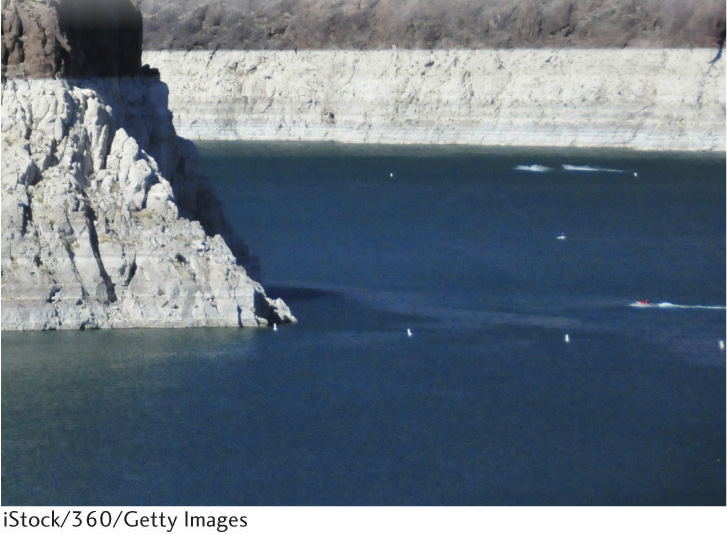
Another area where arid land irrigation has had severe ecological consequences lies on the borderland between Kazakhstan and Uzbekistan in central Asia. The once-huge Aral Sea has become so diminished by the diversion of irrigation water from the rivers flowing into it that large areas of dry lakebed now lie exposed (Figure 8.29). Not only was the local fishing industry destroyed, but also noxious, chemical-laden dust storms now blow from the barren lakebed onto nearby settlements, causing assorted health problems. Irrigation water diverted to huge cotton fields, then, destroyed an ecosystem and produced another desert.
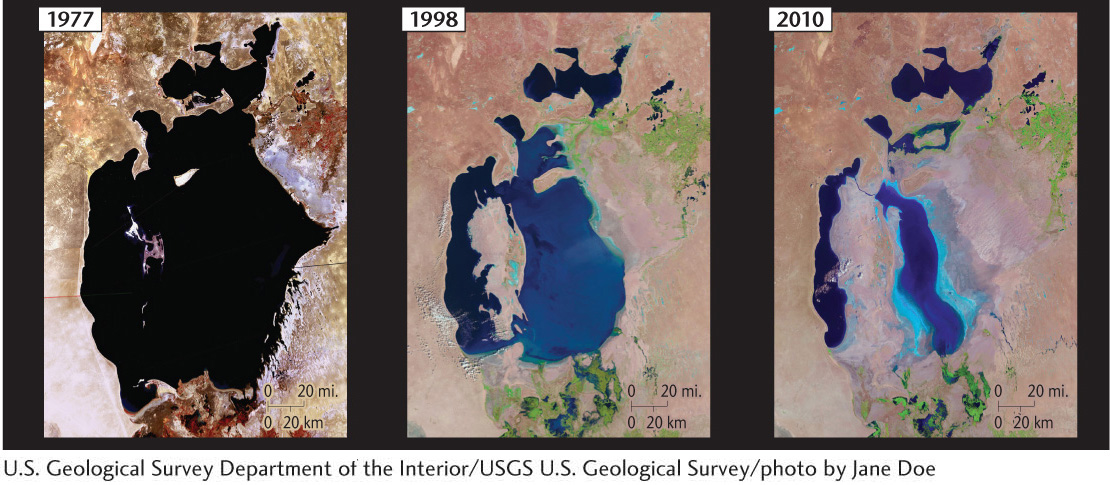
SUSTAINABLE AGRICULTURE
As cultural geography studies by Zimmerer and many others have shown, local and indigenous knowledge about ecological conditions can be a foundation for sustainable agriculture. Sustainability—the survival of a land-use system for centuries or millennia without destruction of the environmental base—is the central ecological issue confronting agriculture today. The case of the Quichua peasants offers an optimistic assessment of indigenous knowledge as the basis for long-term sustainability. Their response to contemporary market pressures suggests that development and conservation can be compatible. Their knowledge of complex and variable ecological conditions in the Andes has allowed them to farm highly diverse crop varieties, a practice that in some cases has been strengthened by economic development.
sustainability
The survival of a land-use system for centuries or millennia without destruction of the environmental base, allowing generation after generation to continue to live there.
348
Another example of sustainable indigenous agriculture is the paddy rice farming that occurs near the margins of the Asian wet-rice region, where unreliable rainfall causes harvests to vary greatly from one year to the next. Farmers have developed complex cultivation strategies to avert periodic famine, including growing many varieties of rice. These farmers, including those in parts of Thailand, almost universally rejected the green revolution. The simplistic advice given to them by agricultural experts working for the Thai government was inappropriate for their marginal lands. Based on generations of experimentation, the local farmers knew that their traditional adaptive strategy of diversification was superior. In West Africa, peasant grain, root, and livestock farmers have also developed adaptations to local environmental influences. They raise a multiplicity of crops on the more humid lands near the coast. Moving inland toward the drier interior, farmers plant fewer kinds of crops but grow more droughtresistant varieties. Having observed many cases like these in which local practices have proved effective and sustainable, most geographers now agree that agricultural experts need to consider indigenous knowledge when devising development plans.
INTENSITY OF LAND USE
Great spatial variation exists in the intensity of rural land use. In intensive agriculture, a large amount of human labor or investment capital, or both, is put into each acre or hectare of land, with the goal of obtaining the greatest output. Intensity can be calculated by measuring either energy input or level of productivity. In much of the world, especially the paddy rice areas of Asia, high intensity is achieved through the prodigious use of human labor, which results in a rice output per unit of land that is the highest in the world. In Western countries, high intensity is achieved through the use of massive amounts of investment capital for machines, fertilizers, and pesticides, resulting in the highest agricultural productivity per capita found anywhere.
intensive agriculture
The expenditure of much labor and capital on a piece of land to increase its productivity. In contrast, extensive agriculture involves less labor and capital.
349
Many geographers support the theory that increased land-use intensity is a common response to population growth. As demographic pressure mounts, farmers systematically discard the more geographically extensive adaptive strategies to focus on those that provide greater yield per unit of land. In this manner, the population increase is accommodated. The resultant farming system may be riskier, because it offers fewer options and possesses greater potential for environmental modification, but it does yield more food—at least in the short run. Other geographers reject this theory, arguing instead that increases in population density follow innovations, such as the introduction of new high-calorie crops, which lead to greater land-use intensity.
GLOBAL WARMING AND THE FUTURE OF AGRICULTURE
For centuries, increased food production has been achieved by converting forests and grasslands to pastures and plowed fields. In many parts of China, India, and the Mediterranean lands, forests virtually vanished. In transalpine Europe (an area north of the Alps), the United States, and some other areas, they were greatly reduced (Figure 8.30). Such large-scale land-use changes led geographers to conclude that agriculture can actually alter regional environmental conditions. In extreme cases, land-use change over an extensive area can produce desertification, a process of desert expansion triggered by human actions such as overgrazing and deforestation. For example, geographer Rhoads Murphey suggested over 60 years ago that farmers caused substantial parts of North Africa to be added to the margins of the Sahara Desert. More recent studies indicate that the Sahara margins expand and contract over time, depending on temporary shifts in rainfall rather than as a result of farmers’ mismanagement.
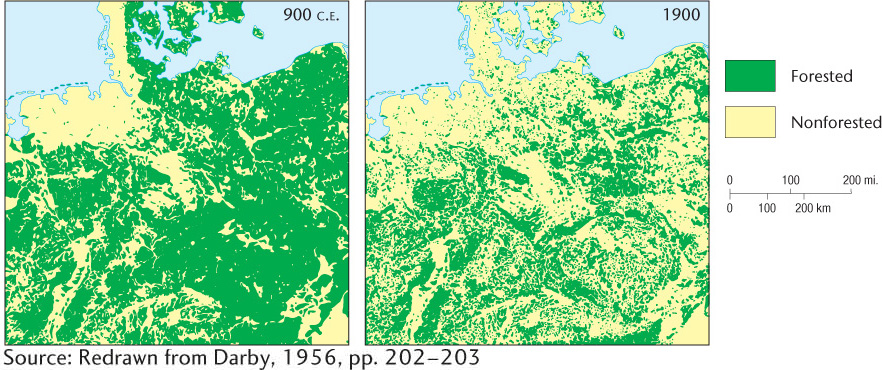
desertification
A process whereby human actions unintentionally turn productive lands into deserts through agricultural and pastoral misuse, destroying vegetation and soil to the point where they cannot regenerate.
While desertification’s relation to farming is still a concern, currently it is the interaction among agricultural land use, food supply, and global warming that is drawing geographers’ attention. The Intergovernmental Panel on Climate Change (IPCC), the scientific body that the United Nations designated to track global climate change, released its Fifth Assessment Report in 2013. Evaluating the research of hundreds of scientists from around the world, the report concludes that the evidence for unprecedented global warming is “unequivocal.” Without reductions in greenhouse gasses, such as CO2, climate conditions will soon be significantly different from those under which humans invented agriculture. That is, the climate conditions that prevailed for millennia and to which our food production systems are adapted are beginning to shift, perhaps radically and irreversibly.
350
352
The interactions are complex. On the one hand, modern agriculture contributes to global warming in several ways. For example, industrial agriculture is powered by fossil fuels, which contribute greenhouse gasses to the atmosphere. Also, the clearing of forests for cultivation or pasture reduces the amount of CO2 removed from the atmosphere by trees. On the other hand, global warming can have negative impacts on food production. For example, one of the IPCC’s predictions for global warming’s effects is an increase in extreme weather, such as droughts and floods, that can reduce regional crop yields. Also, regional climates are expected to shift geographically, which means that some areas currently cultivated will no longer be suitable for agriculture.
In regard to the last point, global warming will first be felt in those regions where poorer farmers operate without significant capital investment at the margins of suitable agricultural environments. Sub-Saharan Africa is a case in point (Figure 8.31). As we have seen, sub-Saharan Africa faces relatively greater challenges than other regions, including a rapidly growing population, high poverty rates, and high rates of malnutrition. In short, the region needs to increase food productivity quickly and significantly. Unfortunately, recent studies indicate declining productivity under most climate change models. In particular, under global warming scenarios, productivity projections for the main African grain crops of sorghum, maize, and millet are negative throughout the region with the exception of a few high-elevation countries.
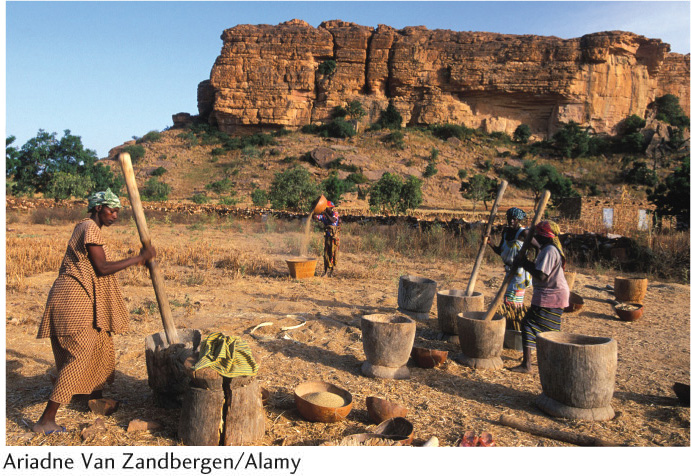
World Heritage Site: Cultural Landscape of Honghe Hani Rice Terraces
World Heritage Site
Cultural Landscape of Honghe Hani Rice Terraces
The Cultural Landscape of Honghe Hani Rice Terraces in Yunnan, China, is one of the most recent additions to the World Heritage Site list. Inscribed in 2013, the site offers visually striking examples of humans’ creative response to environmental limits and of long-term sustainable agricultural production.
◼ Thousands of terraced rice paddies, built over the course of 1300 years, reach down the slopes of the Ailao Mountains to the valley of the Hong River. The entire site covers 1000 square kilometers and three distinct terraced areas: Bada, which is for the most part gently sloped; Duoyishu, which is steeper; and Laohuzui, which is very steep. Eighty-two villages of 50 to 100 households each are located among the terraced fields.
◼ The Hani people, whose ancestors migrated to the region some 2000 years ago, are the predominant ethnic group resident in it. As far back as China’s Tang dynasty (seventh to tenth century C.E.) outside commentators remarked on the Hani’s skill and ingenuity in modifying the mountainsides for agriculture. The Hani migrants initially encountered a forested ridge cut by numerous surface springs fed by underground seepage. The Hani left forest pockets intact to protect the spring sources, built rock terraces to create level ground, and then channeled the water from the springs to irrigate the fields.
◼ Hani religion is rooted in a belief in the sacredness of nature. This spirituality supports ecologically beneficial land-use practices, such as the maintenance of sacred forests and trees in and around Hani villages. The Hani’s efforts over the centuries have produced an integrated nature-culture system that unites forest, dwelling, water, and land to sustainably produce both abundant food and environmental benefits.
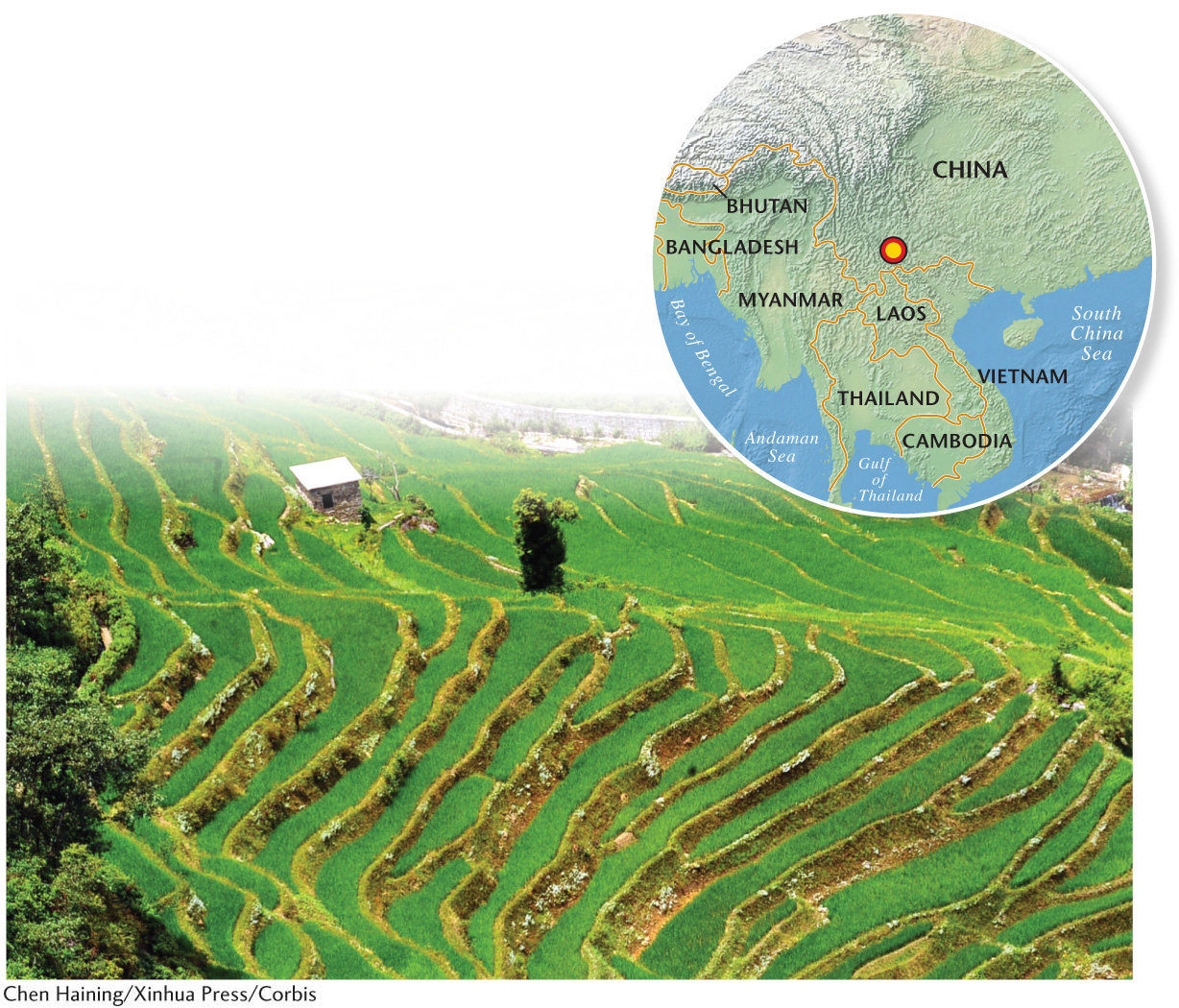
351
ON THE TERRACES: Each household has access to one or two segments of the irrigated terrace (as well as to a house site, fuel and building material from the forest, and pasture). The terraced fields are maintained and cultivated through a complex system of communal obligations and individual entitlements. A fundamental task of this system is the regulation of the movement of water onto and off of tens of thousands of individual fields
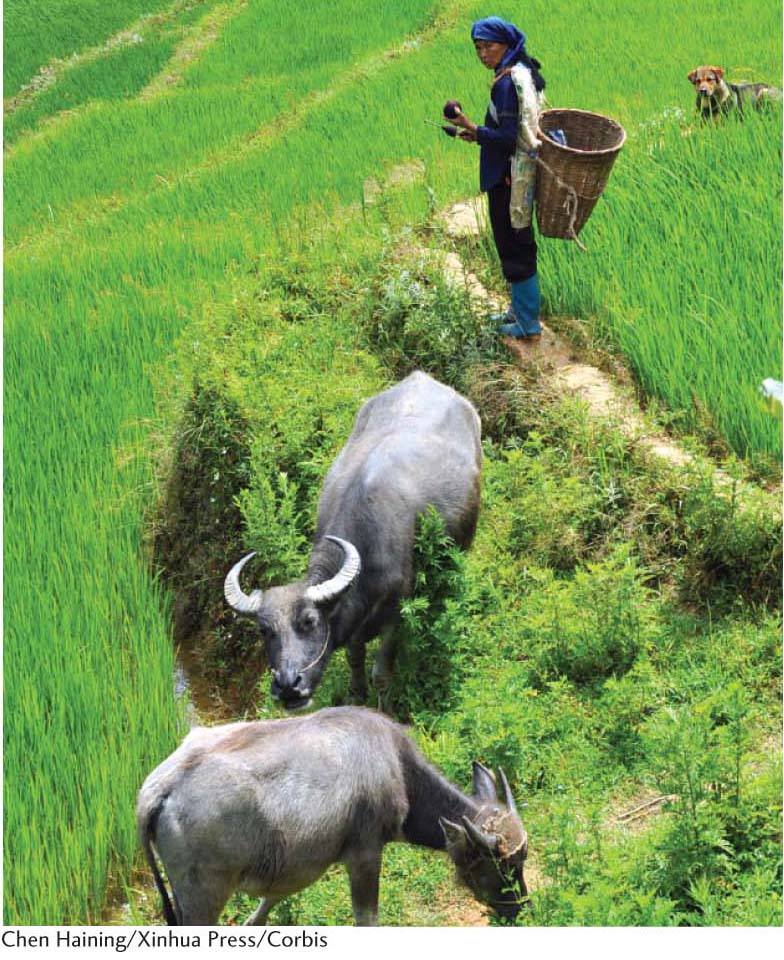
◼ Roughly 445 kilometers of water channels, including 4 trunk canals and 392 branch ditches, crisscross the mountainside. Residents employ bars of wood or stone to direct water through these channels. Each bar is carved with a different-sized outlet so that sufficient water flows to the lower ditches on the slope and each ditch receives the correct amount of water. Ditch leaders are appointed from the villages to maintain the ditches, allocate water, and settle disputes. The villagers, in turn, pay the ditch leader in rice for the service of managing the ditches.
◼ The water itself is nutrient rich, having passed through the forest litter and picked up key minerals. In late winter, this nutrient-laden water is diverted to the fields to fertilize the soil. In addition, residents have established manure ponds where livestock manure is collected during the winter to create a source of organic fertilizer. At the start of spring planting, nutrient-rich water from the ponds is diverted onto the terraces to fertilize the crop.
◼ Along with multiple varieties of rice, residents harvest from the terraces many aquatic herbs and vegetables. Eels, bivalves, snails, fish, shrimp, and other aquatic animals are raised in the water of the flooded fields. Ducks are also part of the system and feed on aquatic animals and vegetation. Soybeans and livestock, including pigs, cattle, and buffalo, are raised on the land between flooded paddies.
TOURISM: The region has no history of mass tourism, though its scenic beauty and dramatic irrigation structures have long attracted photographers from all over the world.
◼ Recent developments, however, including its WHS designation and local transportation infrastructure upgrades, are likely to initiate a wave of touristic activity. The Chinese government has formulated a plan for an ecotourism industry, founded on the region’s reputation as an example of sustainable agriculture within an intact traditional culture.
◼ Future projects include the designation of scenic tourist routes, an information center focused on local culture, the maintenance of traditional architecture, and the promotion of place-based agricultural products.
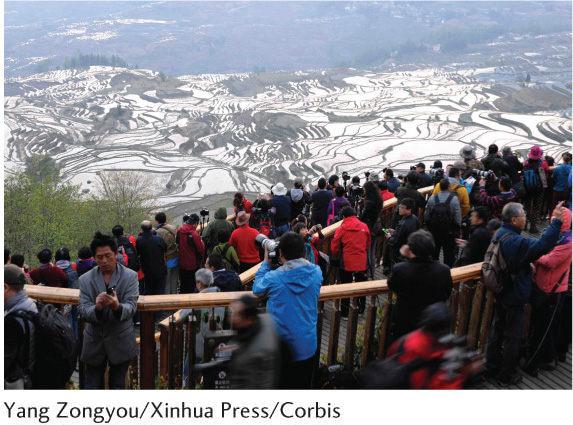
◼ Beginning 1300 years ago, the Hani people of China’s Ailao Mountains constructed an ingenious system of terraced agriculture.
◼ By protecting forests, cycling organic nutrients, and carefully controlling the distribution of water, Hani farming is both highly productive and environmentally sustainable.
◼ Long appreciated by photographers for its scenic beauty, the landscape of the Honghe Hani rice terraces will soon be developed for tourism.
ENVIRONMENTAL PERCEPTION BY AGRICULTURISTS
People perceive the physical environment through the lenses of their culture. Each person’s agricultural heritage can be influential in shaping these perceptions. This is not surprising, because human survival depends on how successfully people can adjust their ways of making a living to environmental conditions.
The Great Plains of the United States provides the setting for how an agricultural experience in one environment influenced farmers’ environmental perceptions and subsequent behavior when they immigrated to the Great Plains. The Plains farmers who came from the humid eastern United States consistently underestimated the problem of drought in their new home. In the 1960s, geographer Thomas Saarinen pointed out that almost every Great Plains farmer, even the oldest and most experienced of the farmers, underestimated the frequency of the dry periods. By contrast, culturally preadapted German-speaking immigrants from the steppes of Russia and Ukraine, an area very much like the American Great Plains, accurately perceived the new land and experienced fewer problems due to drought.
culturally preadapted
A complex of adaptive traits and skills possessed in advance of migration by a group, giving it survival ability and competitive advantage in occupying the new environment.
353
Milk of Human Kindness
![]() Milk of Human Kindness
Milk of Human Kindness
This video features dairy farmer Bob Bansen of Yamhill, Oregon, and his philosophy of sustainable farming. Bansen’s method of raising dairy cattle is contrasted with that of corporate-owned industrialized dairy farms. Industrialized dairy farms are run as food factories where cows are kept confined indoors, sustained with concentrated feeds, and given antibiotics to reduce the spread of disease. Bansen’s family-owned farm produces dairy products by allowing cows to graze outdoors on natural grass, which reduces disease exposure. As a result, the use of antibiotics can be avoided. The video concludes that modern dairy farms can be environmentally sustainable and still profitable, and provide for the humane treatment of animals.
Thinking Geographicaly:
This chapter featured a discussion of sustainable agriculture. How does this case study of an Oregon dairy farm compare with that discussion? Can you identify any underlying principles or philosophy that would link this video with the sustainability discussion in the textbook?
In the video, the interviewer and farmer emphasize the fact that the farmer names and recognizes each individual cow in his herd. What does this practice have to do with his farming philosophy? How does naming his cows help the farmer turn a profit from his dairy farm?
This chapter introduced some of the chemical-intensive practices used in both industrialized cattle feedlots and dairy farms. In the video, the interviewer states, “One of the big worries about industrial agriculture is the overuse of antibiotics.” How has Bansen addressed this concern on his farm? How did his practices change when he converted to organic production? From this one example, what general insights might we draw regarding chemical inputs in industrial farming?
Farmers rely on climatic stability. A sudden spell of unusual weather events can change agriculturists’ environmental perceptions. Geographer John Cross studied Wisconsin agriculture following a series of floods, droughts, and other anomalies. He found that two-thirds of all Wisconsin dairy farmers now believe the climate is changing for the worse, and fully one-third told him that continued climatic variability threatened their operations. Perhaps they perceive the environmental hazard to be greater than it really is, but they make decisions based on their perceptions.
A study of more recent immigration from Mexico into the Midwest by geographer Eric Carter (and associates) shows that interactions with the receiving culture influence the environmental perception of immigrants in complex ways. Most of the immigrants in the study came from agricultural communities in rural Mexico, drawn to the Midwest to work in the livestock and meat-packing industry. On the one hand, immigrants readily adopted some local environmental values, such as the importance of clean, well-maintained public spaces. On the other hand, immigrants criticized the consumerism and materialism of the host culture, which contradicted the environmental values they carried with them from rural Mexico. Thus, it is important to recognize environmental perception as evolving through interactions with nature and among culture groups rather than as frozen in time.
354
DON’T PANIC, IT’S ORGANIC
Alarmed by the ecological and health hazards of chemical-dependent, industrialized agriculture, a small counterculture movement emerged in the United States and Europe in the 1960s and 1970s. Geographer Julie Guthman labels this the organic farming movement. For Guthman, the movement in the United States saw in organic agriculture a solution to a range of social, cultural, political, and environmental ills. These included the loss of small family-owned and -operated farms, environmental pollution from industrial agriculture, corporate control of the food system, and the nutritional deficiencies of highly processed foods.
organic agriculture
A form of farming that relies on manuring, mulching, and biological pest control and rejects the use of synthetic fertilizers, insecticides, herbicides, and genetically modified crops.
When the organic food movement was in its infancy, there was no way to differentiate organically produced animals and crops from the product of what has come to be called conventional agriculture. Movement advocates, many of them based in California, invented new certification systems in the 1970s that focused on the technical aspects of organic agriculture, particularly the absence of artificial fertilizers and petrochemical-based pesticides and herbicides. Certification systems created uniform standards and definitions for organic production but lacked enforcement powers to control fraud. In 1979 California passed the first organic law in the United States, but it took 11 more years before the state added enforcement powers. At the federal level, opposition from corporate agribusiness interests delayed regulatory legislation on organic farming until 1990 and full implementation for another decade.
conventional agriculture
The widely adopted commercial, industrialized form of farming that uses a range of synthetic fertilizers, insecticides, and herbicides to control pests and maximize productivity; a term that emerged following the creation of alternative forms, such as organic farming.
By legislating regulatory standards for organic agriculture, the state and federal governments provided organic farmers the basis for differentiating their product in the marketplace. This, in turn, allowed producers and retailers to charge consumers a premium. Premium pricing has encouraged many producers to switch to organic agriculture. The organic food market is now the most rapidly growing (and most profitable) agricultural sector. Affluent consumer demand for organics in the United States, while only 4 percent of national food and beverage sales, is growing at the phenomenal pace of 20 to 25 percent annually. Land-use practices reflect this growing demand. In the United States, organic crop acreage increased at an annual average rate of 15 percent between 2002 and 2008, with even larger increases in vegetables and fruits. Despite the dramatic growth in acreage, by 2011 organic farms accounted for only .6 percent of total land area in agricultural use.
Organic production in many parts of the world matches or exceeds the United States’ trends. Europe’s expansion of land in organic agriculture is happening at an even greater rate, increasing 61 percent between 2005 and 2011. In several European countries, including Austria, Estonia, and Sweden, at least 15 percent of all agricultural land is used in organic production. In terms of area of land in organic production, Australia has roughly six times the amount as the United States and Argentina nearly double. On the other hand, the United States is by far the world’s largest consumer of organics, accounting for 44 percent of global sales, more than twice the world’s second largest, Germany.
In Guthman’s assessment, the United States organic farming movement, because it focused solely on the technical aspects of organic production, fell short of addressing many of the social and political ills it sought to correct. Her study of California organic agriculture demonstrated that organic farming is readily incorporated into large-scale agribusiness enterprises. Indeed, some existing agribusinesses merely purchased existing organic farms as a means of diversifying their operations and tapping the profits from premium pricing. While organic agriculture has produced environmental and health benefits (for farm laborers and consumers), its effect on the historic decline of family farms and their rural communities has been minimal.
355
GREEN FUELS FROM AGRICULTURE
Henry Ford fueled his first car with alcohol, and Rudolf Diesel ran his engine on fuel made from peanut oil. They soon abandoned these biofuels, however, for nonrenewable fossil fuels derived from “rock oil,” and the rest is history. The modern global economy is dependent on fossil fuels to produce everything that we eat, wear, listen to, read, and live in. Now fossil fuels, particularly oil, have become scarce, causing prices and political uncertainties to increase. In addition, fossil-fuel combustion is a source of atmospheric greenhouse gases, which are partly responsible for global warming. Thus, an urgent search is under way to find alternative, renewable fuel supplies, and agriculture has become one of the main sources.
biofuel
Broadly, this term refers to any form of energy derived from biological matter, increasingly used in reference to replacements for fossil fuels in internal combustion engines, industrial processes, and the heating and cooling of buildings.
How can agriculture be a source of energy for industry? By tapping the simple process of fermentation, many plant materials can be converted to a combustible alcohol, ethanol. In the United States, corn is the main source of ethanol, and new ethanol plants dot the landscape of the Midwestern Corn Belt (Figure 8.32). Responding to federal legislation, U.S. ethanol production expanded more than 600 percent during the first decade of the twenty-first century. By 2013, however, ethanol production had saturated the fuels market to the point where supply exceeded demand. Subsequently, the U.S. government recommended that efforts to expand the share of ethanol in the country’s energy mix be slowed as Midwestern ethanol plants began boarding up.

This shift in corn production from food to fuel affects nearly every aspect of the field crop sector, as well as livestock production, habitat protection, food retailing, and the global grain trade. For example, total planted corn acreage in 2013 was the highest in 75 years. Corn acreage was gained by replacing crops such as cotton and by the environmentally damaging practices of reducing fallow periods and taking over pastures and land set aside for conservation. Also, ethanol for fuel creates a new source of consumer demand that competes with existing demand for food. As a result, the price of corn on the global market rose, with anticipated negative consequences for the poor and undernourished. The situation is made worse when weather, such as the extended droughts of 2012, reduces yields and drive corn prices even further out of reach of the world’s most vulnerable populations.
Brazil, which is the closest international rival of the United States in ethanol production, grows and ferments sugarcane, which yields twice as many gallons of ethanol per acre as does corn. The policies of the Brazilian government have encouraged the creation of a delivery infrastructure (plants, tanks, and pumps) and the manufacture and sale of “flex” cars that can run on either gasoline or ethanol. By 2006 the country had freed itself from a dependence on imported oil, an achievement that many countries only dream of emulating.
Will biofuels from agriculture produce a sustainable, environmentally friendly alternative to fossil fuels? Biofuels appear to offer tremendous promise, yet not without drawbacks. For example, switching farms from food to fuel production raises the specter of food shortages. The environmental benefits of biofuels also may be reduced by some of the associated costs of increasing ethanol and biodiesel production. Biodiesel, fuel made from vegetable oils, takes less energy to produce than crop-based ethanol, but it is typically more expensive than petroleum-derived diesel. These issues are explored further in Subject to Debate.
356